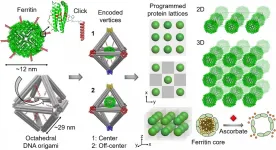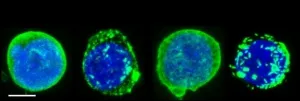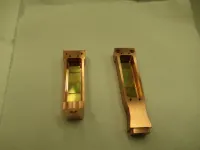(Press-News.org) CHAPEL HILL, NC - When we think of the brain, we think of neurons. But much of the brain is made of non-neuronal cells called glial cells, which help regulate brain development and function. For the first, time UNC School of Medicine scientist Katie Baldwin, PhD, and colleagues revealed a central role of the glial protein hepaCAM in building the brain and affecting brain function early in life.
The findings, published in Neuron, have implications for better understanding disorders, such as autism, epilepsy, and schizophrenia, and potentially for creating therapeutics for conditions such as the progressive brain disorder megalencephalic leukoencephalopathy with subcortical cysts (MLC).
For over one hundred years, the glia were thought of as a bunch of support cells, like a kind of brain glue keeping the more important neurons in place to do the brain's real work. But over the past 30 years, scientists have been teasing apart the importance of glial cells as regulators of brain development and function. Still, much remains unknown, especially about complex glial cells called astrocytes, which extend thousands of fine branches throughout the brain, directly interacting with neurons and other brain cells.
During brain development prior to birth and thereafter, astrocytes establish an intricate network of distinct territories, a sort of tiling of the brain, like the tiles of a soccer ball. These cells use specialized connections, called gap junctions, to communicate throughout this network.
"Both astrocyte tiling and communication through gap junctions are disrupted in different brain disorders and following injury, suggesting these features are important for normal brain function," said Baldwin, the corresponding author, member of the UNC Neuroscience Center, and assistant professor in the UNC Department of Cell Biology and Physiology. "But prior to our study, it was unknown how astrocytes established their territories and whether there was a link between astrocyte territory and gap junction communication, also known as coupling."
In this study, Baldwin and colleagues focused on hepaCAM, a protein abundantly expressed on the astrocyte membranes. They created a transgenic rodent model so the animals did not express any hepaCAM protein in astrocytes. The researchers used this model along with cutting-edge genetic and imaging techniques to study the developing astrocytes, their resulting tile-like territories, and gap junction coupling.
"Deleting hepaCAM from astrocytes disrupted astrocyte territories and impaired gap junction coupling. Essentially, these astrocytes no longer do a good job of communicating with their neighbors," Baldwin said. "We also found that, even though we did not make any disruptions to neurons, loss of hepaCAM in astrocytes altered the balance of synaptic excitation and inhibition." That is, without this protein, astrocyte branches in contact with neurons affected the how neurons behaved.
"We think our findings have important implications for understanding the pathogenesis of MLC, as well as the general role of astrocyte dysfunction as a driving cause of neurological disorders, such as epilepsy," Baldwin said.
Baldwin conducted this work while a postdoctoral fellow in Cagla Eroglu's lab at Duke University before joining UNC-Chapel Hill this past spring. Her lab will continue to focus on the impact of hepaCAM mutations on astrocyte function.
"We are building on this research to explore the bigger question of how astrocytes balance their connections with other cell types in the brain," she said, "with the goal of understanding how problems in astrocytes cause disease in humans, and how we might help people with these serious and complex disorders."
INFORMATION:
Other authors of the study are Cagla Eroglu, Christabel Tan, Samuel Strader, Changyu Jiang, Justin Savage, Xabier Elorza-Vidal, Ximena Contreras, Thomas Rülicke, Simon Hippenmeyer, Raul Estevez, and Ru-Rong Ji.
The National Institutes of Health, a Holland Trice Brain Research Award, a Foerster-Bernstein Family Postdoctoral Fellowship, The Hartwell Foundation, and the European Research Council funded this research.
TAMPA, Fla. -- E-cigarettes spark many concerns, especially when it comes to youth vaping. However, emerging evidence suggests that e-cigarettes can be a helpful tool in smoking cessation. Researchers in Moffitt Cancer Center's Tobacco Research and Intervention Program wanted to build upon this evidence by testing whether they could help dual users, people who use both combustible cigarettes and e-cigarettes, quit smoking. In a new article published in The Lancet Public Health, they report results from a first-of-its kind nationwide study evaluating a targeted intervention aimed at transforming dual users' e-cigarettes from a product that might ...
CHAPEL HILL, NC - Developing a viable vaccine against dengue virus has proved difficult because the pathogen is actually four different virus types, or serotypes. Unless a vaccine protects against all four, a vaccine can wind up doing more harm than good.
To help vaccine developers overcome this hurdle, the UNC School of Medicine lab of Aravinda de Silva, PhD, professor in the UNC Department of Microbiology and Immunology, investigated samples from children enrolled in a dengue vaccine trial to identify the specific kinds of antibody responses that correlate with ...
UPTON, NY--Scientists have organized proteins--nature's most versatile building blocks--in desired 2-D and 3-D ordered arrays while maintaining their structural stability and biological activity. They built these designer functional protein arrays by using DNA as a programmable construction material. The team--representing the U.S. Department of Energy's (DOE) Brookhaven National Laboratory, Columbia University, DOE's Lawrence Berkeley National Laboratory, and City University of New York (CUNY)--described their approach in the June 17 issue of Nature Communications.
"For decades, scientists have dreamed about rationally assembling proteins into specific organizations with preserved protein function," ...
Scientists from within the Antibody and Vaccine Group at the University of Southampton have gained novel insights into how an important class of immune receptors called tumour necrosis factor receptors (TNFR) are activated.
The work, published in the journal Communications Biology, investigates a class of receptors present on immune cells called TNFR. These receptors, such as CD40, 4-1BB and OX40, are key in helping the immune system fight pathogens and cancer cells. Accordingly, antibody drugs which are designed to specifically target and activate these receptors (called ...
People with dementia receiving home health care visits are less likely to be readmitted to the hospital when there is consistency in nursing staff, according to a new study by researchers at NYU Rory Meyers College of Nursing. The findings are published in the journal Medical Care, a journal of the American Public Health Association.
Home health care--in which health providers, primarily nurses, visit patients' homes to deliver care--has become a leading source of home- and community-based services caring for people living with dementia. These individuals often have multiple chronic conditions, take several medications, and need assistance with activities of daily living. In 2018, more than 5 million Medicare beneficiaries received ...
COLUMBUS, Ohio - Although the United States is the only wealthy nation that doesn't guarantee paid leave to mothers or fathers after the arrival of a new child, Americans endorse providing paid time off for parents nearly as much as people from other countries.
About 82% of Americans support paid maternity leave, just slightly less than the 86% who support it in 26 wealthy nations, a new study shows.
Where Americans differ from the rest of the world is that they are less supportive of government funding for paid leaves, prefer shorter leave times and are less supportive of paid leave for fathers.
"We find marked differences in how Americans want paid leave administered compared ...
Singularities such as those at the centre of black holes, where density becomes infinite, are often said to be places where physics 'breaks down'. However, this doesn't mean that 'anything' could happen, and physicists are interested in which laws could break down, and how.
Now, a research team from Imperial College London and the Cockcroft Institute and Lancaster University have proposed a way that singularities could violate the law of conservation of charge. Their theory is published in Annalen der Physik.
Co-author Professor Martin McCall, from the Department of Physics at Imperial, said: "'Physics breaks down at a singularity' is one of the most famous statements in pop-physics. But by ...
To make computer chips, technologists around the world rely on atomic layer deposition (ALD), which can create films as fine as one atom thick. Businesses commonly use ALD to make semiconductor devices, but it also has applications in solar cells, lithium batteries and other energy-related fields.
Today, manufacturers increasingly rely on ALD to make new types of films, but figuring out how to tweak the process for each new material takes time.
Part of the problem is that researchers primarily use trial and error to identify optimal growth conditions. But a recently published study -- one of the first in this scientific field -- suggests that using artificial intelligence (AI) can be more efficient.
In the ACS Applied ...
ALBUQUERQUE, N.M. -- Like two superheroes finally joining forces, Sandia National Laboratories' Z machine -- generator of the world's most powerful electrical pulses -- and Lawrence Livermore National Laboratory's National Ignition Facility -- the planet's most energetic laser source -- in a series of 10 experiments have detailed the responses of gold and platinum at pressures so extreme that their atomic structures momentarily distorted like images in a fun-house mirror.
Similar high-pressure changes induced in other settings have produced oddities like hydrogen appearing as a metallic fluid, helium in the form of rain and sodium a transparent metal. But until now there has been no way to accurately calibrate these pressures and responses, the first step to ...
Tsukuba, Japan - Organic light-emitting diodes (OLEDs) are widely used in display technology and are also being investigated for lighting applications. A comprehensive understanding of these devices is therefore important if their properties are to be harnessed to their full potential. Researchers from the University of Tsukuba have directly observed the photoexcited electron dynamics in an organic film using time-resolved photoelectron emission microscopy. Their findings are published in Advanced Optical Materials .
OLED displays are popular because they are bright, lightweight, and do not consume a lot of power. Their output is generated when an exciton--a combination of an electron and an electron hole--releases its energy. However, this ...




